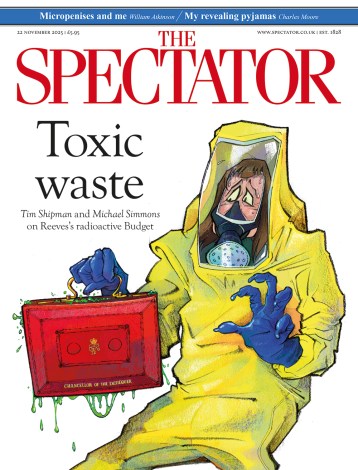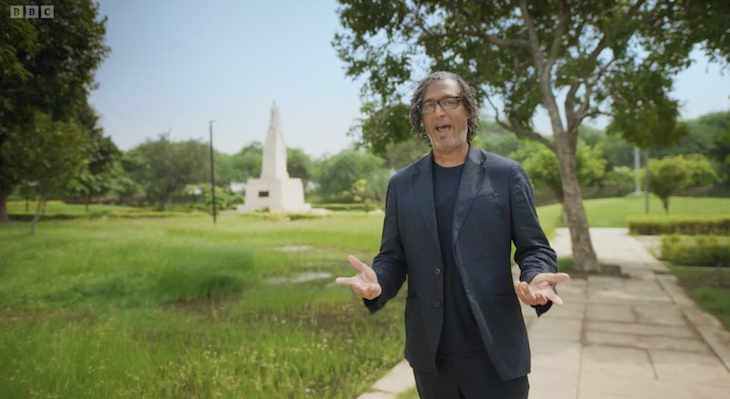Nusret Gökçe, the Turkish social media sensation known as Salt Bae, has a restaurant empire built around the fan base for his incredibly expensive planks of steak; £680 for a wagyu strip loin, for instance, skirt steak for £380 and gold-gilded baklava for £50. Based in London at the Knightsbridge restaurant Nusr-Et, Salt Bae tried to expand in the US to big fanfare, opening restaurants in New York, Beverly Hills, Boston and Miami in the late 2010s.
But it seems that Salt Bae has fallen out of step with the times and his US expansion is crumbling. The American business reported losses of £5.4 million in the last tax year. Having opened seven branches, there are now only two in the US: one in New York’s ghastly mid-town and one in Miami.
It is strange that, with his ludicrous gold-rimmed sunglasses, gold medallion and appalling little moustache, Salt Bae ever became a real business proposition in the first place
Things haven’t been all that cheerier in Knightsbridge. Sales went up by £1 million to £10 million last year, but the UK business reported a loss of £5.5 million last year, after profit of £1.7 million the previous year. Salt Bae drew footballers Ronaldo and David Beckham to eat his 24-karat steak in Knightsbridge.
To me it is strange that with his ludicrous little gold-rimmed black sunglasses (worn even inside while doing things with steak), gold medallion and appalling little moustache, Salt Bae ever became a real business proposition in the first place. I certainly would not like this man anywhere near my meat, and that’s without the £600 price tag.
That his appeal is clearly on the wane is even less hard to fathom. Protein looks like it has had its day: what better proof than that Starbucks has just introduced protein coffee in the US, where whey isolate is mixed in with milk? The thin and glossy are now keener on fibre than they were five years ago. It’s not easy to ‘fibremaxx’ in a Salt Bae, though a few of the £22 starter salads do contain nuts and greens.
Then there is the competition. I follow hundreds of Instagram and Tik Tok cooking accounts, and this is a landscape full of content makers with millions of followers each, reels showing them whipping up cheap and cheerful chicken alfredo jacket potato or a crunchy rice salad sometimes getting upward of 60 million views.
The popularity of recipe reels come down to two nice things: ASMR (relaxing sounds and visuals of chopping, carving, sizzling etc) and ways of penny pinching while still enjoying restaurant-quality food. He may have 52.4 million followers for now, but compared to what else is out there, Salt Bae’s reels are poorly made, choppy, and boring, lacking narrative and sensuality.
Then there is the elephant in every single room, at home or out: the cost of living. Inflation and supply issues have ruined the experience of eating out for those who may formerly have seen fit to splurge as a special treat. I rarely do it now because it’s not fun paying £22 for a salad, or £14 for a tiny bit of veg and cheese, or £50 for some meat, when you could have a taste explosion at home.
Accounts and celebrity chefs that do particularly well rely heavily on clever ways with beans, lentils, rotisserie chicken, yoghurt, olive oil, and the kind of spices that last months or years. They do one-pot and traybake dinners for families that use sauces and spices cleverly, they do salads for five that look like a million bucks but cost £2 for ingredients. They offer hacks, they show you how to live well and more healthily on less, creating a glamorous enclave in your own kitchen with pretty pots and pans and plates and mixing bowls and cool gadgets.
And then there’s the Ozempic effect. Salt Bae’s customers are more likely to be sports, finance and tech bros and their glossy, surgeried womenfolk, not the types who on a night in cook a Deliciously Ella orzo root vegetable bake or a gluten and sugar free peanut butter banana bread. Many of them will be on fat jabs. And as has been well publicised, those on GLP-1s will struggle to eat a whole steak at the best of times, let alone to the tune of £600.
As the very existence of Dubai attests, there is still a strong market for pure bling, whether that’s gold toilets or gold baklava. But that market is becoming more regionally pinpointed in the East, and has fallen out of step with the more frugal, inward-looking sensibilities of the bean-counters, and bean-eaters, of the squeezed West.









Comments